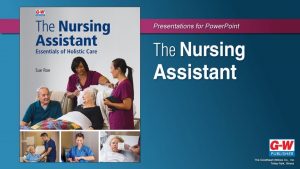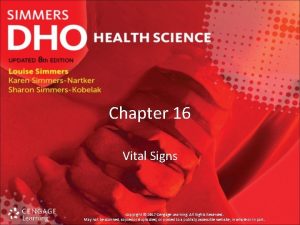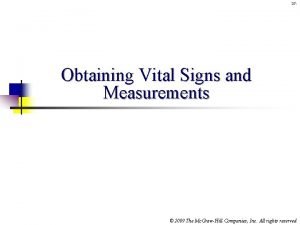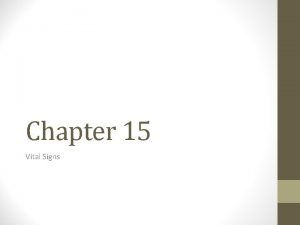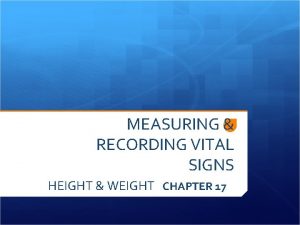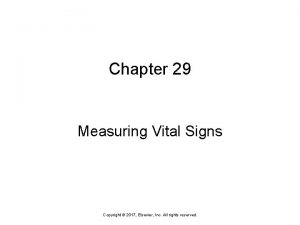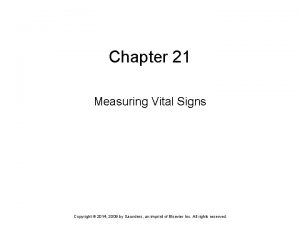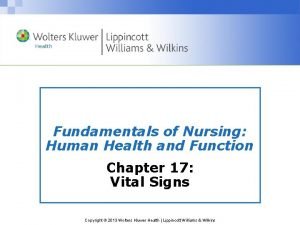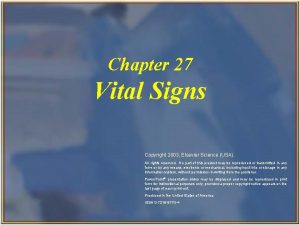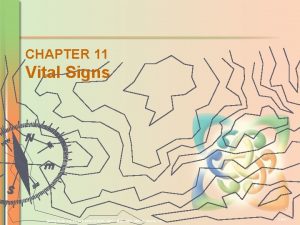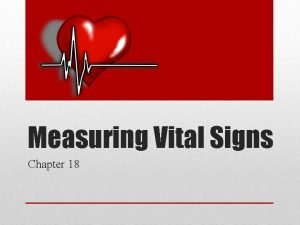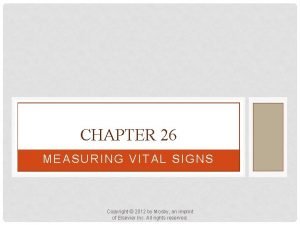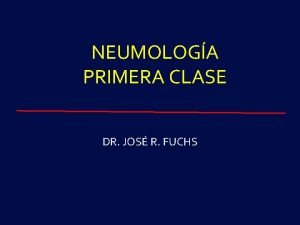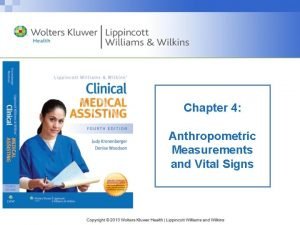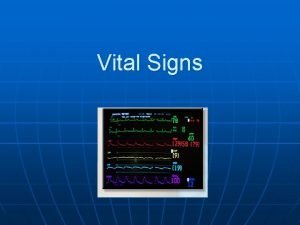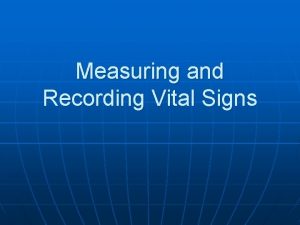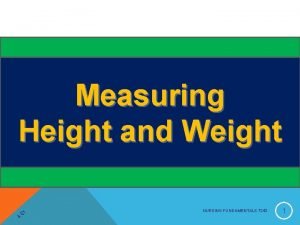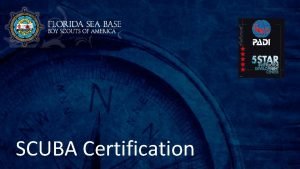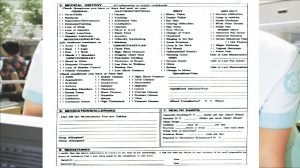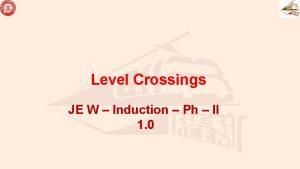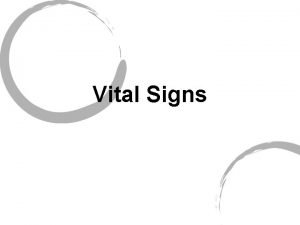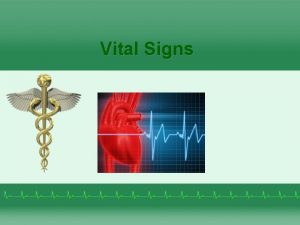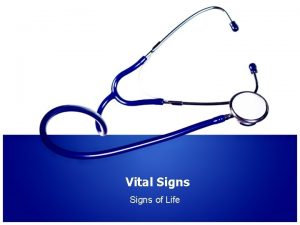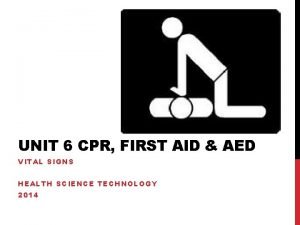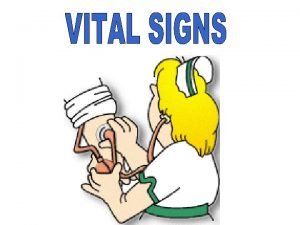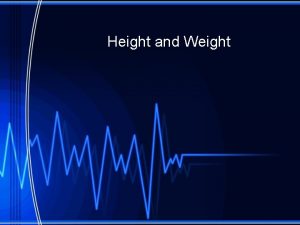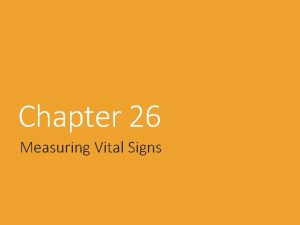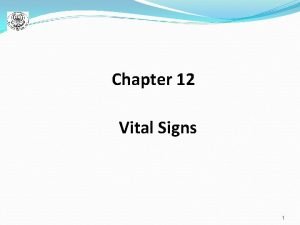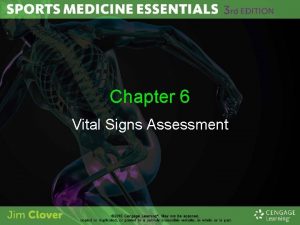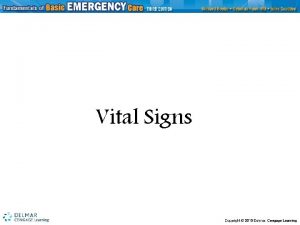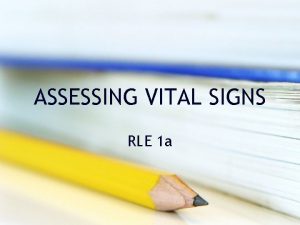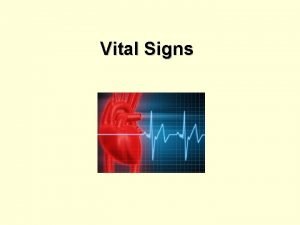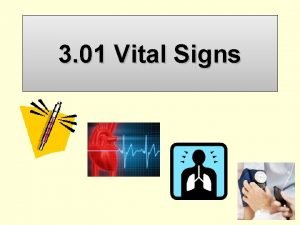Chapter 18 Vital Signs Height and Weight Section











































- Slides: 43


Chapter 18 Vital Signs, Height, and Weight

Section 18. 1 Measuring and Recording Vital Signs

Objectives • discuss the purpose and importance of taking vital signs; • identify the normal and abnormal ranges of vital signs; • describe the locations and methods used to take vital signs; (continued) Copyright Goodheart-Willcox Co. , Inc. May not be posted to a publicly accessible website.

Objectives • list the equipment needed to take vital signs; • describe the importance of using a pulse oximeter; and • explain how to measure and record vital signs accurately and effectively. Copyright Goodheart-Willcox Co. , Inc. May not be posted to a publicly accessible website.

The Importance of Vital Signs • Help diagnose diseases and determine effective treatments • Process is the same for children and adults, but preferred methods change with age • Guidelines determine normal vital sign ranges Rocketclips, Inc. /Shutterstock. com Copyright Goodheart-Willcox Co. , Inc. May not be posted to a publicly accessible website.

Temperature • Recorded in degrees (°) and measures body heat in either Fahrenheit (F) or Celsius (C) • Changes over course of a day due to dilation and expansion of blood vessels • Regulated by the hypothalamus Copyright Goodheart-Willcox Co. , Inc. May not be posted to a publicly accessible website.

Temperature Locations Oral Rectal Temporal artery Axillary Tympanic Blurry. Me/Shutterstock. com; © Body Scientific International; Pixie. Me /Shutterstock. com; Mut Hardman/Shutterstock. com; JPC-PROD/Shutterstock. com Copyright Goodheart-Willcox Co. , Inc. May not be posted to a publicly accessible website.

Average Body Temperatures • Average temperature for adults: 98. 6°F (37. 0°C) • Average rectal approximately 1°F (0. 6°C) higher • Average axillary and temporal artery approximately 1°F (0. 6°C) lower • May fluctuate during the day due to exertion, how much is consumed, or external temperature • Hypothermia—body temperature below 95°F (35°C) Copyright Goodheart-Willcox Co. , Inc. May not be posted to a publicly accessible website.

Types of Thermometers Nondigital Disposable oral Digital Tympanic Temporal artery catshila/Shutterstock. com; AGorohov/Shutterstock. com; Wards Forest Media, LLC; luk/Shutterstock. com; Michael Dechev/Shutterstock. com Copyright Goodheart-Willcox Co. , Inc. May not be posted to a publicly accessible website.

Procedure Using an Oral Thermometer—Digital Read through the procedure for using a digital oral thermometer. With a partner, discuss what you need to assess before you take a resident’s oral temperature to make sure the reading is accurate. Copyright Goodheart-Willcox Co. , Inc. May not be posted to a publicly accessible website.

Procedure Using a Rectal Thermometer—Digital Read through the procedure for using a digital rectal thermometer. Then, quiz a partner on the supplies you need to do this procedure. Copyright Goodheart-Willcox Co. , Inc. May not be posted to a publicly accessible website.

Procedure Using an Axillary Thermometer— Digital Read through the procedure for using a digital axillary thermometer. Then, explain why measuring axillary temperature should not be your first choice when taking a resident’s temperature. Wards Forest Media, LLC Copyright Goodheart-Willcox Co. , Inc. May not be posted to a publicly accessible website.

Procedure Using a Tympanic Thermometer— Digital Read through the procedure for using a digital tympanic thermometer. This type of thermometer relies on exact placement to get an accurate reading. With a partner, practice how to position the ear when using a tympanic thermometer. Copyright Goodheart-Willcox Co. , Inc. May not be posted to a publicly accessible website.

Procedure Using a Temporal Artery Thermometer —Digital Read through the procedure for using a digital temporal artery thermometer. With a partner, discuss why this type of temperature is more accurate than oral temperature. For which age group would this thermometer work best? Copyright Goodheart-Willcox Co. , Inc. May not be posted to a publicly accessible website.

Pulse • Pressure of blood against walls of arteries when the heart contracts and relaxes • Common locations to measure pulse: • Radial artery—located at the wrist • Apical artery—located at apex of heart; measured with stethoscope • Carotid artery—located near bottom of neck Copyright Goodheart-Willcox Co. , Inc. May not be posted to a publicly accessible website.

Pulse Rate Measurements • Measured by counting number of beats per minute (bpm) using a watch • Affected by activity, anxiety, excitement, pain, fever, medications, sleep patterns, and diseases or health conditions • Bradycardia—pulse slower than 60 bpm • Tachycardia—pulse faster than 100 bpm • Must also count rhythm between beats Copyright Goodheart-Willcox Co. , Inc. May not be posted to a publicly accessible website.

Procedure Measuring a Radial Pulse With a partner, read through the procedure for measuring a radial pulse. Take turns locating the radial pulse on one another and counting the beats per minute. Copyright Goodheart-Willcox Co. , Inc. May not be posted to a publicly accessible website.

Procedure Measuring an Apical Pulse Read through the procedure for measuring an apical pulse. Then, answer the following questions: • How should you prepare a stethoscope before taking a resident’s apical pulse? • Where should you place the stethoscope on a resident’s body? Copyright Goodheart-Willcox Co. , Inc. May not be posted to a publicly accessible website.

Rate of Respiration • Measurement of a resident’s breathing cycle (inhalation followed by exhalation) • Helps determine level of blood oxygenation • To measure, record number of full breaths in one minute • Normal rate is 12– 20 breaths per minute, but infants and children breathe faster (continued) Copyright Goodheart-Willcox Co. , Inc. May not be posted to a publicly accessible website.

Rate of Respiration • When counting respirations, note if breathing is: • Regular or irregular • Deep and rapid (hyperventilation) or slow and shallow (hypoventilation) • Rapid (tachypnea), deep and labored (dyspnea), or unusually slow (bradypnea) • Noisy like snoring (stertorous breathing) • Absent (apnea) Copyright Goodheart-Willcox Co. , Inc. May not be posted to a publicly accessible website.

Discuss • Why is it best to check a resident’s respiration rate right after pulse while leaving your fingers on the radial artery? Copyright Goodheart-Willcox Co. , Inc. May not be posted to a publicly accessible website.

Procedure Counting Respirations Read through the procedure for counting respirations. Next, practice calculating a classmate’s respiration rate. Count for 15 seconds while watching the clock, then multiply the number of respirations by four to get your partner’s respiration rate per minute. Make sure to note the regularity and depth of breaths. Copyright Goodheart-Willcox Co. , Inc. May not be posted to a publicly accessible website.

Using a Pulse Oximeter • Measures blood oxygenation by showing percentage of oxygen in the blood • Normal amount of oxygen is between 95 and 100 percent • Hypoxia—less than 85 percent oxygen in the blood toysf 400/Shutterstock. com Copyright Goodheart-Willcox Co. , Inc. May not be posted to a publicly accessible website.

Blood Pressure • Force of blood pushing against the body’s arterial walls • Hypotension—low blood pressure; body is not getting enough oxygen • Hypertension—high blood pressure; too much pressure placed on walls of arteries Copyright Goodheart-Willcox Co. , Inc. May not be posted to a publicly accessible website.

Measuring Blood Pressure • Blood pressure levels: • Systolic—heart muscle contracts and pushes blood through arteries; first beat heard • Diastolic—heart muscle relaxes; last beat heard • Measured in millimeters of mercury (mm. Hg) and recorded as a fraction Copyright Goodheart-Willcox Co. , Inc. May not be posted to a publicly accessible website.

Factors Affecting Blood Pressure ü Diet, weight, and exercise ü Race ü Time of day ü Position ü Drugs, cigarettes, alcohol, or medications ü Stress, fear, or pain Copyright Goodheart-Willcox Co. , Inc. May not be posted to a publicly accessible website.

Taking Blood Pressure • Can be measured electronically or manually using stethoscope and sphygmomanometer • Manual aneroid and electronic • Important to ensure proper size • Avoid using arms with IV catheters, casts, or wounds kurhan/Shutterstock. com Copyright Goodheart-Willcox Co. , Inc. May not be posted to a publicly accessible website.

Procedure Taking a Blood Pressure Read through the procedure for taking a blood pressure. Then, with a partner, answer the following questions: • How do you apply the cuff of a sphygmomanometer on a resident’s arm? • What do you think a patient’s blood pressure would be if he or she came to the ER with abdominal pain? Would it be high, low, or normal? Why? Copyright Goodheart-Willcox Co. , Inc. May not be posted to a publicly accessible website.

Review • How do you measure an apical pulse? • What is the normal respiration rate for an adult? • Explain the difference between tachypnea and bradypnea. • List three factors that can affect a resident’s blood pressure. Copyright Goodheart-Willcox Co. , Inc. May not be posted to a publicly accessible website.

Section 18. 2 Measuring and Recording Height and Weight

Objectives • describe why height and weight measurements are important to know when providing care; and • demonstrate the skills needed to measure height and weight accurately and effectively for ambulatory, wheelchair-bound, and bedridden residents. Copyright Goodheart-Willcox Co. , Inc. May not be posted to a publicly accessible website.

Importance of Height and Weight • Allows staff to monitor resident’s health, determine nutritional changes, and prescribe appropriate medications • Height and weight used to calculate ideal body weight (IBW) and body mass index (BMI) • Help doctors plan calorie intake and protein and fluid needs Copyright Goodheart-Willcox Co. , Inc. May not be posted to a publicly accessible website.

Measuring Height For residents who can walk For bedridden residents JPC-PROD/Shutterstock. com; © Tori Soper Photography Copyright Goodheart-Willcox Co. , Inc. May not be posted to a publicly accessible website.

Discuss • Describe the types of equipment you can use to measure the height of a resident. Copyright Goodheart-Willcox Co. , Inc. May not be posted to a publicly accessible website.

Measuring Weight • Used to calculate medication dosages and indicate certain conditions • Measured using upright balance or digital, sling, or chair scales • Important to factor in items that add weight, such as shoes, casts, catheters, or colostomy bags Copyright Goodheart-Willcox Co. , Inc. May not be posted to a publicly accessible website.

Procedure Measuring the Height and Weight of Ambulatory Residents Read through the procedure for measuring the height and weight of an ambulatory resident. Then, discuss with a partner why you should weigh a resident at the same time every day. Why is it essential that you record an accurate weight? Copyright Goodheart-Willcox Co. , Inc. May not be posted to a publicly accessible website.

Procedure Measuring the Height of Bedridden Residents Read through the procedure for measuring the height of a bedridden resident. Write down what you can do to ensure the safety of the resident during this procedure. Copyright Goodheart-Willcox Co. , Inc. May not be posted to a publicly accessible website.

Procedure Weighing Bedridden Residents Using a Hydraulic Digital Lift or Sling Bed Scale Read through the procedure for weighing bedridden residents using a hydraulic digital lift or a sling bed scale. Discuss how teamwork plays a role in this type of procedure. Amélie Benoist/Science Source Copyright Goodheart-Willcox Co. , Inc. May not be posted to a publicly accessible website.

Review • Explain the difference between IBW and BMI. • What measurements are used to record a resident’s height? • What measurements are used to record a resident’s weight? • Give examples of items that may affect a resident’s weight on a scale. Copyright Goodheart-Willcox Co. , Inc. May not be posted to a publicly accessible website.

Practice Question A pulse of fewer than 60 beats per minute is called A. tachypnea B. bradycardia C. bradypnea D. hypotension Copyright Goodheart-Willcox Co. , Inc. May not be posted to a publicly accessible website.

Practice Question Which set of adult vitals should you report immediately to the licensed nursing staff? A. 98. 6°F, 64 bpm, 12 breaths per minute, 100/66 mm. Hg. B. 98. 0°F, 78 bpm, 14 breaths per minute, 110/74 mm. Hg. C. 101. 8°F, 52 bpm, 28 breaths per minute, 168/92 mm. Hg. D. 98. 8°F, 86 bpm, 18 breaths per minute, 98/62 mm. Hg. Copyright Goodheart-Willcox Co. , Inc. May not be posted to a publicly accessible website.

Practice Question Which of the following is false regarding height and weight? A. Additional items like shoes should be considered. B. Tape measures can be used to measure bedridden residents. C. Weight helps doctors determine medication dosages. D. Weight can be measured at different times each day. Copyright Goodheart-Willcox Co. , Inc. May not be posted to a publicly accessible website.
 Vital signs height and weight
Vital signs height and weight Divided highway begins sign
Divided highway begins sign Measuring and recording apical pulse
Measuring and recording apical pulse Chapter 36 body measurements and vital signs
Chapter 36 body measurements and vital signs Chapter 16.6 measuring and recording apical pulse
Chapter 16.6 measuring and recording apical pulse Vital sign normal
Vital sign normal Measuring and recording apical pulse
Measuring and recording apical pulse Chapter 15:6 measuring and recording apical pulse
Chapter 15:6 measuring and recording apical pulse Chapter 21:1 measuring/recording height and weight
Chapter 21:1 measuring/recording height and weight Chapter 29 measuring vital signs
Chapter 29 measuring vital signs Measuring vital signs chapter 21
Measuring vital signs chapter 21 Fundamentals of nursing chapter 17 vital signs
Fundamentals of nursing chapter 17 vital signs Chapter 27 vital signs
Chapter 27 vital signs Test chapter 16 vital signs
Test chapter 16 vital signs Chapter 11 vital signs
Chapter 11 vital signs Chapter 26 measuring vital signs
Chapter 26 measuring vital signs Apical radial pulse
Apical radial pulse Capacidad vital y capacidad vital forzada
Capacidad vital y capacidad vital forzada Anthropometric measurement includes vital signs
Anthropometric measurement includes vital signs Dr lucy jennifer
Dr lucy jennifer Measuring and recording temperature
Measuring and recording temperature Regularity of the pulse or respirations
Regularity of the pulse or respirations Nursing responsibilities in taking height and weight
Nursing responsibilities in taking height and weight Lynx weight
Lynx weight The most dramatic gains in height and weight occur
The most dramatic gains in height and weight occur Sea base weight requirements
Sea base weight requirements Yahusef ben avraham
Yahusef ben avraham Height and weight form
Height and weight form Omar bradley height and weight
Omar bradley height and weight Examples of bulk reducing products
Examples of bulk reducing products Lc gate inspection
Lc gate inspection Vital sign
Vital sign Normal level of vital signs
Normal level of vital signs Respiration as a vital sign
Respiration as a vital sign 6 vital signs
6 vital signs Vital signs normal range for pediatrics
Vital signs normal range for pediatrics Temperature
Temperature 8 vital signs
8 vital signs Sv times hr
Sv times hr 8 vital signs
8 vital signs Normal range for vital signs
Normal range for vital signs Conclusion for vital signs
Conclusion for vital signs Vital signs cpr
Vital signs cpr Artery parts of the body to locate pulse beat
Artery parts of the body to locate pulse beat
